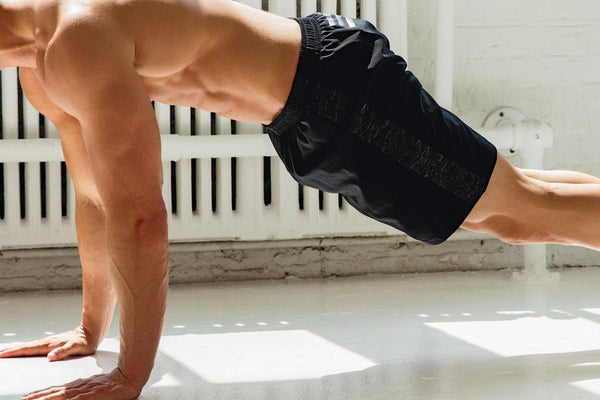There was a time not too long ago that core training was all the rage in the fitness industry, and for good reason -- a strong core helps stabilize the spine, reduce your risk of injury, enhance athletic performance, and improve your posture.
In recent times, core training has fallen out of the spotlight and taken a backseat to flashier forms of training. Yet, it is the core that allows us to excel in whatever form of exercise or physical activity we choose to engage in.
Today, we take a deeper look at the why the core (or as it’s known in the research community, LPHC) is so important and how to strengthen it to improve performance and reduce the risk of injury.
What is the LPHC?
LPHC stands for
You may know the LPHC by its more common name -- the core.
Most people tend to think of the core as just the abdominals, but the truth is that the LPHC is comprised of the lumbar spine, pelvis, and hip musculoskeletal structures as well as the abdominals.
Why is the LPHC Important?
The LPHC serves as your center of gravity from where all power, speed, and explosiveness is generated.
The LPHC also serves an important role in stabilizing the upper and lower body, enabling you to generate force.
Remember, you are only as strong as you are stable. What this means is that in order to exert maximal force on an object, you must be stable.
Basically, any sort of athletic movement you do (squatting, jumping, pressing, etc.) requires a strong and stable LPHC. Without it, performance is compromised, and the likelihood of injury increases significantly.
How so?
When your core is weak or unstable, your body compensates for the instability by recruiting other muscles that aren’t typically involved in a particular movement. Every now and then, some compensation is fine. After all the human body is incredibly durable and built to withstand (and adapt) to just about anything.
However, when auxiliary structures are constantly forced to bear a load that they weren’t meant to bear, wear and tear ensues, leading to dysfunction, strain, pain, and injury.
What Causes LPHC Dysfunction?
Unfortunately, there is no singular cause of LPHC dysfunction.
Many will be quick to point out that weak glutes or abs are the culprit behind LPHC dysfunction.
And, while they may be a contributor to the problem, the truth is that a great many muscles can play a role in the development and progression of LPHC dysfunction, including:
- Gastrocnemius
- Soleus
- adductor complex
- Hamstrings
- Gluteus medius
- Gluteus maximus
- TFL/IT Band
- hip flexors
- Erector spinae
- Abdominals
- Llatissimus dorsi
Essentially, when one or more muscle groups is not working as it should, or isn’t being loaded properly over and over again, dysfunction ensues.
Improper breathing or bracing can also be a contributing factor.
Think about it, when you press a bar overhead or squat with a bar on your back, you have to be tight from head to toe.
Any “slack” in your kinetic chain leads to a reduction in force output as well as stress being dumped onto structures (joints, ligaments, tendons, ancillary supporting muscles, etc.) that weren’t meant to bear it in the first place. If this happens often enough or to a severe enough degree pain, discomfort, and injury will transpire.
Research has found that poor LPHC strength can affect tibiofemoral and patellofemoral joint movement and the manner in which forces affect those joints across multiple planes of motion.[1]
Other injuries that can be developed as a result of an unstable LPHC include:
- Plantar fasciitis
- IT band syndrome
- Patellofemoral pain (a.k.a. “Runner’s knee”)
As you can see, building and maintaining a strong, stable core is of the utmost importance if you want to lead a long, productive, and relatively pain free fitness lifestyle.
With that in mind, let’s now turn our attention towards the various exercises you can incorporate into your training program to enhance LPHC strength and stability.
How to Build LPHC (Core) Strength & Stability
What follows is a beginner and intermediate LPHC strength program that is designed to improve your ability to contract, recruit, and stabilize the many muscles of the LPHC.
As you move through these programs, remember to keep your ego in check and focus on form and proper execution above all else.
The pursuit to continually add weight to the bar and/or outlift others in the gym is likely a contributing factor as to why you may have developed a weak core. After all, moving a lot of heavy weight is fun, not to mention impressive.
But, the ego can be a dangerous thing as it often leads us to tackle more than we can do with proper form.
These workouts can be used included as part of your warm-up prior to your heavy lifting for the day (to ensure that all the surrounding core musculature is prepped and ready to go). It can also serve as an active recovery or off day workout.
Beginner LPHC Strength & Stability Program
|
Exercise |
Sets |
Reps |
|
Glute Bridge |
3 |
10 |
|
Lightweight Band (or Cable) Pull Through |
3 |
10 |
|
Lateral mini band walks |
3 |
10 / each side |
|
Superman |
3 |
5 (10 sec hold) |
|
Stationary Lunge |
3 |
8 |
|
Fire Hydrants |
3 |
10 / leg |
|
Frog Pumps |
3 |
10-15 |
Intermediate LPHC Strength & Stability Program
|
Exercise |
Sets |
Reps |
|
Single-Leg Glute Bridge |
3 |
10 / leg |
|
Band Pull Through |
3 |
10 |
|
McGill Single-Leg Sit Up |
3 |
8-10 |
|
Mini-Band Monster Walks |
3 |
4 steps forward, 4 steps backward |
|
Double mini-band lateral walks (wrapped above knees and ankles) |
3 |
10/side |
|
Quadruped Banded Hip Extension |
3 |
10 / leg |
|
Goblet Squats |
3 |
10-12 |
Takeaway
The LPHC is the foundation upon which all athletic performance is built. It serves as the link between the lower body and upper body, and enables you to transfer forces generated by the lower body through the upper body.
The more stable and strong your core is, the more strength, power, speed, and explosivity you have.
Use the tips in this article to build a rock-solid LPHC and be on your way to better performance and less aches and pains.
References
- Oleksy L, Bylina D, Mika A, Soltan J, Kielnar R (2018) The Relationship Between Lumbo-Pelvic-Hip Complex and Knee Joint Dysfunctions. J Nov Physiother 8: e149. DOI: 10.4172/2165-7025.1000e149






